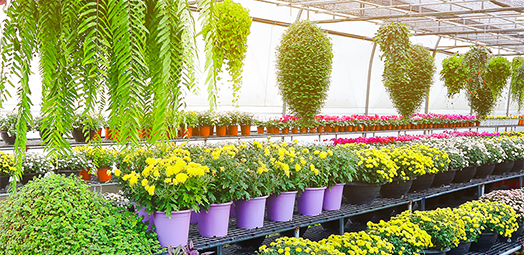
The co-dependency of insects to plants and flowers proves to be quite a dynamic relationship. Many insects, like pollinators, play a crucial role in plant life cycle. Others pose a threat to the health and potential value of our most important plants!
Learn how to identify these common insects in greenhouses and nurseries to protect your bottom line:
Aphid: Aphids secrete honeydew that damages plants and attracts ants. They infest a variety of crops from bedding and garden plants to potted plants, cut flowers and cut greens. Check out Enstar® AQ and Mavrik Aquaflow® insecticide to control aphids on plants.
Bagworm: Found in North, South, and Central America, the bagworm targets trees like juniper, arborvitae, live oak, Southern red cedar, willow, maple, elm and pine. Larvae travel on the wind, find a host to feed on, and use camouflage to cover their bags.
Chinch Bug: Chinch bugs damage turf and pasture grass in the southern U.S. and some western states. They have half wings and piercing mouths used to suck plant juices. Practice proper fertilization, irrigation, mowing, and pest control to reduce infestations.
Fire Ant: With a copper brown head and dark abdomen, fire ants bite, sting and inject toxic alkaloid venom, posing a danger to human, plant, and animal life. They nest in moist soil and often hide their fire ant nests. For an effective fire ant treatment, check out Extinguish® Plus.
Fungus Gnat: You'll notice a fungus gnat infestation by wilting, yellowing plants with poor growth and foliage. They swarm when plants are disturbed. Check out Enstar® AQ for the control of fungus gnat larvae and Mavrik Aquaflow® insecticide insecticide to control adult fungus gnats.
Leafhopper: Leafhoppers use their piercing/sucking mouths to rob plants of essential nutrients, feeding on the sap tissue of plants, and blending into surroundings. Both expert jumpers and strong flyers, leafhoppers spread diseases from plant to plant.
Mealybug: If you've spotted white fuzzy bugs on plants, you likely have a mealybug infestation. These wingless insects with short tails slip into plant cervices and suck their sap, causing stunted growth. For an effective mealybug treatment, Enstar® AQ can help prevent large populations and Mavrik Aquaflow® insecticide can be used in tandem to control a broad mealybug infestation.
Mite: Mites look like tiny moving dots under plant foliage. They make leaves yellow, brown, and blotchy with scraping mouths that extract nutrients from plants, cut flowers and foliage. For control of adult mites on plants, try Mavrik Aquaflow® insecticide.
Mosquito: Mosquitoes have thousands of species and are famous vectors of disease, including the Zika virus. They lay eggs in stagnant water and feed on various hosts, including mammals, birds, reptiles, amphibians, and fish.
Psyllid: These tiny sap suckers look like cicadas, but are much smaller. They attack citrus, olive, potato and tomato crops. Psyllids thrive in warmth, causing discoloration and pock marks on leaves, or sooty mold that grows on excreted honeydew.
Scale: Wax-covered or shiny, the scale insect is found on leaves, branches, trunks, roots and fruits. They infest greenhouse plants, cut flowers, cut greens and foliage. Enstar® AQ can be used alone, but for broad-spectrum control, try Mavrik Aquaflow® insecticide.
Thrips: Thrips change color throughout their lifecycles, ranging from white, yellow, and orange to brown and black. They leave tiny black spots of feces on plants and cause damage with scraping mouths. To control adult thrips on plants, use Mavrik Aquaflow® insecticide.
Whitefly: These oval-shaped, winged insects stunt growth by feeding on the underside of leaves with piercing mouths. They plague various plants and cut flowers. For effective whitefly control, try a combination of Enstar® AQ and Mavrik Aquaflow® insecticide.


